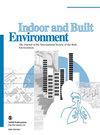健身中心几何参数配置优化研究的同型聚类优化算法
IF 2.9
3区 工程技术
Q2 CONSTRUCTION & BUILDING TECHNOLOGY
引用次数: 0
摘要
尽管许多节能技术和可持续建筑设计已成功降低了建筑能耗并提高了用户满意度,但很少有人考虑建筑空间配置对室内环境的影响。本研究以一家健身中心为重点,采用了基于计算流体动力学(CFD)模拟的优化方法。该研究的优化目标是提高室内通风效率和调节温度,从而优化建筑空间特征。本研究提出了同源聚类优化算法(HCO),以解决现有优化方法的局限性。它还将 HCO 与多目标进化交配算法(MOMA)进行了比较。系数为 8 的 HCO 比 MOMA 性能更好。HCO 生成的帕累托边界更加简洁,计算时间减少了 52%。此外,对 CFD 模拟结果的分析表明,在本研究中,界面宽度系数的影响大于界面高度的影响,空腔宽度的影响大于空腔高度的影响。空气龄变化与几何参数变化之间的关系与室内温度变化类似。本文章由计算机程序翻译,如有差异,请以英文原文为准。
Homotypic clustering optimization algorithm for fitness centre geometric parameter configuration optimization study
Although many energy-saving technologies and sustainable building designs have successfully reduced building energy consumption and improved user satisfaction, little consideration has been given to the impact of building spatial configuration on the indoor environment. This study focused on a fitness centre and employed an optimization methodology based on computational fluid dynamics (CFD) simulation. The optimization aims of this study were to enhance interior ventilation efficiency and regulate temperature, resulting in the optimal building spatial characteristics. This work presents the homologous clustering optimization algorithm (HCO) as a solution to the limitations of existing optimization approaches. It also compares HCO with the multi-objective evolutionary mating algorithm (MOMA). HCO with a coefficient of eight performed better than MOMA. The Pareto frontier generated by HCO was more succinct, and the computational time was reduced by 52%. Moreover, an analysis of the CFD simulation results revealed that, in the context of this study, the influence of the interface width coefficient was greater than that of the interface height, and the impact of the cavity width was greater than that of the cavity height. The relationship between changes in air age and variations in geometric parameters was similar to that of indoor temperature.
求助全文
通过发布文献求助,成功后即可免费获取论文全文。
去求助
来源期刊

Indoor and Built Environment
环境科学-工程:环境
CiteScore
6.40
自引率
25.00%
发文量
130
审稿时长
2.6 months
期刊介绍:
Indoor and Built Environment publishes reports on any topic pertaining to the quality of the indoor and built environment, and how these might effect the health, performance, efficiency and comfort of persons living or working there. Topics range from urban infrastructure, design of buildings, and materials used to laboratory studies including building airflow simulations and health effects. This journal is a member of the Committee on Publication Ethics (COPE).
 求助内容:
求助内容: 应助结果提醒方式:
应助结果提醒方式:


